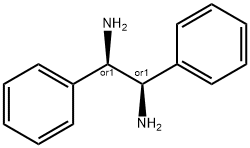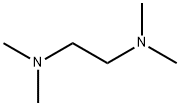(±)-1,2-Diphenylethylenediamine , 98%(T) , 16635-95-3
Synonym(s):
trans-1,2-Diphenylethylene;trans-1,2-Diphenylethylene;trans-Stilbene
CAS NO.:16635-95-3
Empirical Formula: C14H16N2
Molecular Weight: 212.29
MDL number: MFCD00064300
EINECS: 605-438-1
| Pack Size | Price | Stock | Quantity |
| 5G | RMB351.20 | In Stock |
|
| 25G | RMB1264.00 | In Stock |
|
| others | Enquire |
PRODUCT Properties
| Melting point: | 123-125 °C(lit.) |
| Boiling point: | 305-307 °C744 mm Hg(lit.) |
| Density | 0.97 g/mL at 25 °C(lit.) |
| storage temp. | Keep in dark place,Inert atmosphere,2-8°C |
| solubility | soluble in Methanol |
| form | powder to crystal |
| pka | 9.78±0.10(Predicted) |
| color | White to Yellow to Orange |
| CAS DataBase Reference | 16635-95-3(CAS DataBase Reference) |
Description and Uses
1,2-Diphenylethylenediamine (DPE) has been found to react in a neutral medium with catecholamines and other catechol compounds in the presence of hexacyanoferrate(III) to give a compound that fluoresces intensely. The reaction is accelerated by amino acids such as glycine. Nohta et al. described a sensitive spectrofluorimetric method for determining catecholamines with 1,2diphenylethylenediamine. The method is based on the reaction of catechol compounds in a neutral medium with 1,2-diphenylethylenediamine in the presence of hexacyanoferrate(II1) and glycine at ambient temperature. The fluorescence shows excitation and emission maxima around 345 and 480 nm, respectively. The method is simple, selective for catechol compounds, and very sensitive. Catecholamines can be determined at concentrations as low as 15-20 pmol ml-1[1].
Safety
| Symbol(GHS) |  GHS07 |
| Signal word | Warning |
| Hazard statements | H315-H319 |
| Precautionary statements | P264-P280-P302+P352+P332+P313+P362+P364-P305+P351+P338+P337+P313 |
| Hazard Codes | Xn,N |
| Risk Statements | 22-36-51/53 |
| Safety Statements | 26-36/37-61 |
| RIDADR | 2735 |
| WGK Germany | 2 |
| RTECS | WJ4926500 |
| HS Code | 2921.59.8090 |



